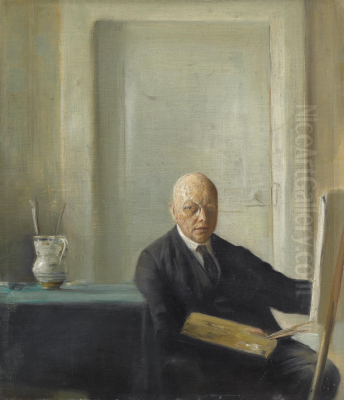
Carl Vilhelm Holsøe stands as a significant figure in Danish art history, celebrated particularly for his mastery in depicting serene and light-filled domestic interiors. Active during the late 19th and early 20th centuries, Holsøe carved a distinct niche for himself, often associated with his close contemporaries Vilhelm Hammershøi and Peter Ilsted. Together, they formed the core of what is often termed the Copenhagen Interior School. Holsøe's work is characterized by its quiet elegance, meticulous attention to detail, and profound sensitivity to the play of light within enclosed spaces, offering intimate glimpses into the bourgeois life of his time. His paintings invite contemplation, capturing moments of stillness and introspection with a subtle, yet powerful, visual poetry.
Early Life and Artistic Formation
Carl Vilhelm Holsøe was born on March 12, 1863, in Aarhus, Denmark. His father, N.P.C. Holsøe, was a respected architect, suggesting an early exposure to design and spatial aesthetics might have influenced the young Carl. Seeking formal artistic training, Holsøe moved to Copenhagen and enrolled at the prestigious Royal Danish Academy of Fine Arts (Det Kongelige Danske Kunstakademi) in 1882. He studied there until 1884, a period during which the Academy was a crucible of artistic development in Denmark.
During his time at the Academy, and subsequently at the independent study school Kunstnernes Frie Studieskoler, Holsøe had the invaluable opportunity to learn under Peder Severin Krøyer (commonly known as P. S. Krøyer). Krøyer was one of the most prominent figures associated with the Skagen Painters, a group renowned for their naturalistic depictions of fishermen and coastal life, often emphasizing plein-air painting and the effects of natural light. While Holsøe would eventually turn his focus inward, Krøyer's emphasis on light and realistic observation likely provided a strong technical foundation for his future work. Holsøe's talent was recognized early, earning him several stipends that supported his studies and artistic development.
Development of a Signature Style
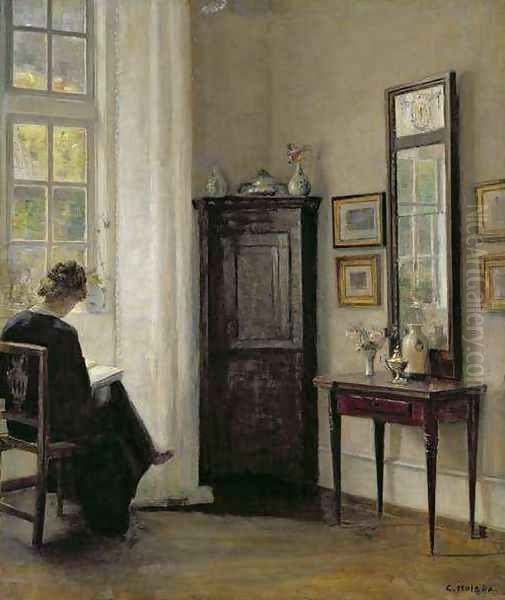
Following his formal education, Holsøe began to cultivate his distinctive artistic voice. While many Danish artists of the era, like his teacher Krøyer or fellow Skagen painters such as Michael Ancher and Anna Ancher, focused on outdoor scenes or portraiture with a strong narrative element, Holsøe gravitated towards the interior. He became a specialist in genre scenes set within well-appointed, yet often understated, domestic spaces – typically the living rooms, studies, and dining rooms of upper-middle-class Copenhagen homes.
His paintings are renowned for their tranquil atmosphere. He masterfully captured the way sunlight streams through windows, illuminating dust motes in the air, reflecting off polished wooden floors, and highlighting the textures of fabrics and the smooth glaze of porcelain. Elegant furniture, often in dark woods like mahogany, features prominently, alongside carefully arranged objects: vases (sometimes Royal Copenhagen porcelain), books, musical instruments, mirrors, and paintings hanging on the walls. These elements are rendered with meticulous care, showcasing Holsøe's keen eye for detail and texture. However, his work transcends mere technical proficiency; it evokes a palpable sense of quietude and contemplation.
The Copenhagen Interior School: Holsøe, Hammershøi, and Ilsted
Carl Holsøe is inextricably linked with two other prominent Danish artists: Vilhelm Hammershøi and Peter Ilsted. These three painters shared a profound interest in depicting domestic interiors, focusing on mood, light, and spatial composition over explicit narrative. Their styles, while distinct, possess a shared sensibility that led critics and art historians to group them together. They were friends and colleagues, often exhibiting together, particularly at Den Frie Udstilling (The Free Exhibition), an artists' association founded in 1891 as an alternative to the established Charlottenborg Spring Exhibition, allowing for greater artistic freedom.
The personal connections between them were also strong. Carl Holsøe married Emilie Heise (born Ilsted) in 1894, making Peter Ilsted his brother-in-law. Vilhelm Hammershøi, in turn, married Ida Ilsted, Peter's sister and thus also Emilie's sister. This made Holsøe and Hammershøi brothers-in-law through their marriages into the Ilsted family. This close personal and professional network undoubtedly fostered a shared artistic dialogue. Emilie Holsøe frequently served as a model in her husband's paintings, adding a layer of intimacy to his work.
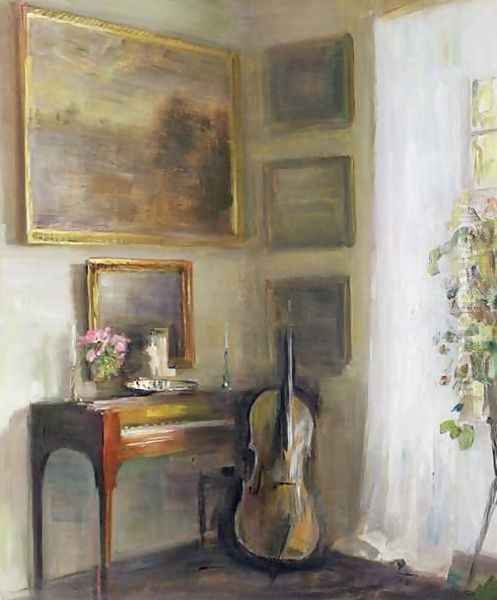
While often discussed as a trio, subtle differences mark their individual approaches. Hammershøi's interiors are perhaps the most austere and enigmatic, often featuring stark compositions, a highly restricted palette, and figures seen from behind, emphasizing psychological distance and existential quiet. Peter Ilsted, also known for his exquisite mezzotints, often employed a slightly warmer palette and more detailed rendering than Hammershøi. Holsøe's work, compared to Hammershøi's, often feels warmer and slightly more inviting, with a richer, though still subdued, use of color and a clearer sense of lived-in space. While still prioritizing atmosphere, his paintings sometimes contain gentle hints of narrative or human presence that feel less remote than in Hammershøi's canvases.
Themes and Motifs: The Poetry of the Everyday
Holsøe's paintings consistently explore a set of recurring themes and motifs centered around the quiet beauty of domestic life. Solitary female figures are frequent subjects, often depicted engaged in quiet activities such as reading, sewing, writing letters, or simply sitting in contemplation near a window. These figures are rarely shown interacting directly with the viewer; instead, they are absorbed in their own world, contributing to the overall sense of intimacy and introspection. The focus is less on the individual's specific identity and more on the universal human experience of quietude and reflection within a personal space.
Light itself is a primary subject in Holsøe's work. He was fascinated by the subtle shifts in illumination throughout the day, capturing the cool, clear light of a Nordic morning, the softer glow of an afternoon sunbeam, or the gentle diffusion of light on an overcast day. Windows are crucial compositional elements, acting as the source of light and a connection to the outside world, yet the emphasis remains firmly on the interior sanctuary. Reflections in mirrors, polished furniture, and glass objects add complexity and depth to his compositions, demonstrating his technical skill in rendering different surfaces and light effects.
Even when figures are absent, Holsøe's rooms feel imbued with a sense of human presence. An open book on a table, a cello leaning against a chair, or a carefully arranged tea set suggest recent activity or impending return. These "empty" interiors, much like some of Hammershøi's, focus attention purely on the architecture of the space, the interplay of light and shadow, and the inherent beauty of the objects within, transforming mundane settings into spaces of aesthetic contemplation. He found poetry in the ordinary, elevating simple domestic scenes to a level of high art through his sensitive observation and refined technique.
Technique and Palette: Capturing Subtlety
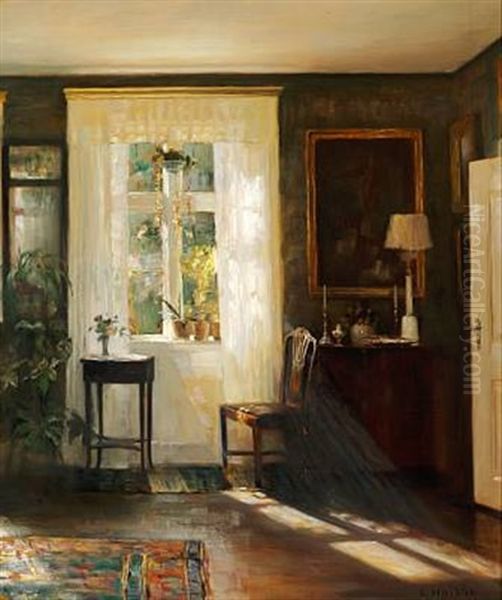
Holsøe's technical approach was characterized by careful drawing, smooth brushwork, and a sophisticated understanding of tonal values. He built up his surfaces with thin layers of paint, achieving a refined finish that allowed for subtle gradations of light and color. While meticulous in his rendering of details, his work avoids photographic literalism; there is a softness and painterly quality that enhances the atmospheric effect.
His palette was generally subdued, favoring harmonious arrangements of grays, creams, browns, ochres, and muted blues and greens. However, within this restrained range, he achieved remarkable richness and nuance. He was particularly adept at capturing the subtle shifts in color temperature as light moved across different surfaces. Occasional accents of stronger color – the red of a book cover, the blue pattern on porcelain, the deep green of upholstery – are carefully placed to draw the eye and add visual interest without disrupting the overall harmony.
Comparisons are often drawn between the light effects in Holsøe's work and those of the 17th-century Dutch Masters, particularly Johannes Vermeer and Pieter de Hooch. Like Vermeer, Holsøe excelled at depicting light falling through windows and illuminating quiet interior scenes. However, Holsøe's work reflects a different sensibility, imbued with the introspective mood and perhaps a touch of the melancholy often associated with Nordic art and literature of the late 19th and early 20th centuries. His handling of light and shadow (chiaroscuro) also shows an understanding of principles mastered by artists like Rembrandt van Rijn, adapted to his own tranquil subject matter. The quiet dignity he bestowed upon domestic objects also echoes the still-life traditions, perhaps recalling the intimate focus of Jean-Baptiste-Siméon Chardin.
Career and Recognition
Carl Holsøe achieved considerable success and recognition during his lifetime. He made his official debut at the prestigious Charlottenborg Spring Exhibition in Copenhagen in 1886, the main venue for established artists. His work was well-received, and he continued to exhibit regularly both at Charlottenborg and, significantly, at Den Frie Udstilling, aligning himself with the more progressive artistic currents in Denmark.
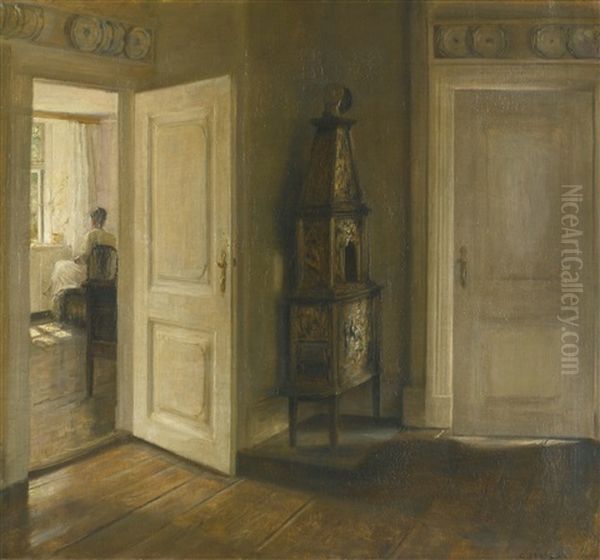
His talent was formally acknowledged through several awards. He was twice awarded the Eckersberg Medal (Eckersberg Medaillen), one of the Royal Danish Academy of Fine Arts' highest honors, in 1901 and 1908. This recognition underscored his standing within the Danish art establishment, despite his association with the independent Free Exhibition. He was also elected a member of the Academy's plenary assembly. Furthermore, Holsøe played an active role in artists' organizations, serving on the board of Den Frie Udstilling and participating in the National Art Exhibition Association (Foreningen National Kunst).
Holsøe's reputation extended beyond Denmark. He exhibited internationally, notably participating in the Exposition Universelle in Paris in 1889. A significant international accolade came in 1911 when he was awarded a gold medal at the International Art Exhibition in Munich. This award highlights the appeal of his refined interior scenes to a broader European audience. A study trip to Italy in 1897, likely funded by one of his stipends, would also have broadened his artistic horizons, although his core subject matter remained rooted in Danish domesticity.
Representative Works: Visions of Stillness
While Holsøe produced a substantial body of work, certain paintings exemplify his characteristic style and themes. Titles are often descriptive and straightforward, focusing on the scene depicted.
Interior with Woman Reading (numerous variations): This is perhaps Holsøe's most iconic subject. These paintings typically show a woman seated near a window, absorbed in a book. The compositions often emphasize the geometry of the room – the lines of floorboards, door frames, and furniture – contrasted with the soft fall of light and the quiet concentration of the figure. The specific identity of the reader is less important than the atmosphere of peaceful solitude and intellectual engagement.
The Artist's Wife, Emilie Holsøe, Seated Sewing by a Window: This work adds a personal dimension, depicting his wife engaged in another common quiet domestic activity. The focus remains on the interplay of light, the textures of fabric and furniture, and the serene mood. Knowing the sitter is the artist's wife invites contemplation on the relationship between artist, model, and domestic space.
Interior with Cello (variations exist): These paintings introduce a musical element. A cello, often leaning against a chair or wall, becomes a significant compositional element. Its elegant curves and warm wood tones add visual interest. Sometimes a figure is present, perhaps contemplating playing or having just finished; other times, the instrument stands alone, suggesting the potential for music and adding a layer of quiet melancholy or anticipation to the scene.
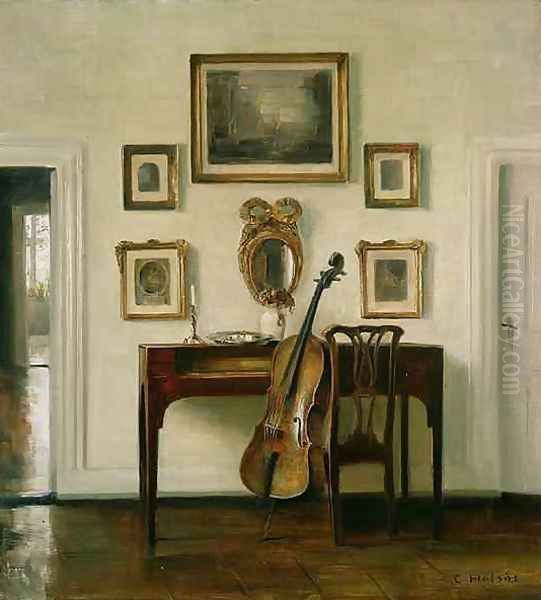
Sunshine in the Living Room or Empty Interior: In these works, Holsøe focuses entirely on the architecture of the room and the effects of light. Sunlight streams dramatically across the floor, highlighting patterns and textures. The absence of figures emphasizes the stillness and allows the viewer to appreciate the space itself as the primary subject, showcasing Holsøe's ability to imbue even unoccupied rooms with mood and character. These works often draw the closest comparisons to Hammershøi's explorations of empty space.
Contemplation: While the specific image associated with this title might vary (as it was used for auction), it encapsulates the predominant mood of Holsøe's oeuvre – a sense of quiet reflection and inner thought, mirrored in the tranquil settings he depicted.
Context, Influences, and International Parallels
Holsøe worked during a period of transition in European art. In Denmark, the legacy of the Danish Golden Age (first half of the 19th century) was still felt, while new movements like Realism, Symbolism, and eventually Modernism were emerging. Holsøe and his circle carved out a unique path, blending realistic observation with a strong emphasis on mood and atmosphere that resonates with Symbolist sensibilities, although they are not typically classified strictly as Symbolists like fellow Danes J.F. Willumsen or Ejnar Nielsen.
His debt to the 17th-century Dutch masters like Vermeer, de Hooch, and Gabriel Metsu is undeniable, particularly in their shared fascination with light, domesticity, and meticulous rendering. Yet, Holsøe filtered these influences through a late 19th-century lens, creating works that feel distinctly modern in their psychological quietude.
Internationally, parallels can be drawn, though direct influence is harder to trace. The tonal harmonies and evocative moods in some of James McNeill Whistler's portraits and interiors share a certain aesthetic kinship with Holsøe's work. While stylistically very different, the intimate domestic scenes painted by French artists like Édouard Vuillard and Pierre Bonnard (the Nabis) also explore the enclosed world of the interior, though often with a bolder palette and more decorative approach. Holsøe's focus remained more aligned with a Northern European tradition of reserved observation and subtle light effects.
Legacy and Reception
During his lifetime, Carl Holsøe was a respected and commercially successful artist. His paintings appealed to the tastes of the bourgeois collectors who appreciated their technical skill, refined aesthetics, and tranquil subject matter. For a period after his death in Asserbo, North Zealand, on November 7, 1935, his reputation, like that of Hammershøi and Ilsted to some extent, was somewhat overshadowed by the rise of Modernism. Traditional representational painting, particularly quiet interior scenes, fell out of critical favor for a time.
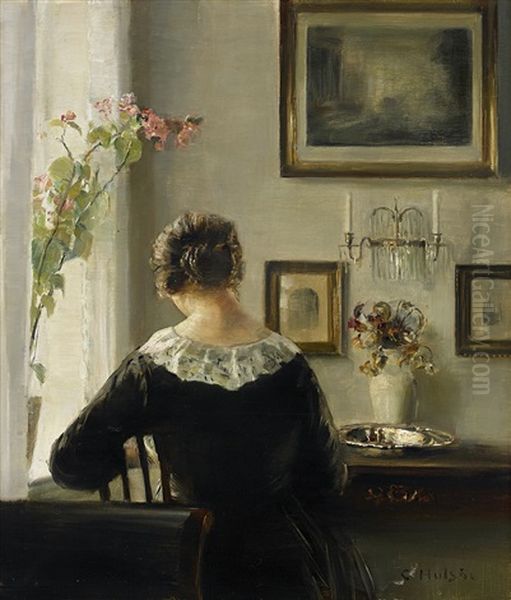
However, in recent decades, there has been a significant resurgence of interest in the work of Holsøe and his circle. Vilhelm Hammershøi, in particular, has achieved major international recognition, which has, in turn, shone a new light on his close associates, Holsøe and Ilsted. Holsøe's paintings are now highly sought after by collectors, and auction prices for his work have risen considerably, reflecting a renewed appreciation for his subtle artistry. The painting Contemplation, for instance, carried a significant estimate (£30,000-£50,000) at a past auction, indicating strong market interest.
While some might perceive his work as lacking the dramatic intensity or overt innovation of other art movements, its strength lies precisely in its quietude and subtlety. Holsøe was a master of understatement, capable of evoking profound emotion and beauty through the careful observation of light, space, and the simple moments of everyday life. His paintings offer a timeless meditation on domesticity, solitude, and the search for peace within one's own environment.
Conclusion: A Master of Quietude
Carl Vilhelm Holsøe remains a pivotal figure in Danish art, a painter who dedicated his career to exploring the nuanced beauty of the interior world. Alongside Vilhelm Hammershøi and Peter Ilsted, he defined a particular mode of painting that prioritized atmosphere, light, and psychological resonance over narrative or overt drama. His technical proficiency, particularly his exquisite handling of light and texture, is undeniable. More importantly, his works possess an enduring power to draw viewers into their serene, contemplative spaces. They capture a specific moment in Danish cultural history – the quiet elegance of turn-of-the-century bourgeois life – but they also speak to universal human desires for tranquility, introspection, and the appreciation of beauty in the everyday. Carl Holsøe was, in essence, a poet of light and stillness, leaving behind a legacy of paintings that continue to resonate with their quiet intensity and refined elegance.